Pelvic and thigh musculature in frogs (Anura) and origin of anuran jumping locomotion
- PMID: 19166476
- PMCID: PMC2667921
- DOI: 10.1111/j.1469-7580.2008.01006.x
Pelvic and thigh musculature in frogs (Anura) and origin of anuran jumping locomotion
Abstract
Comparative analysis of the anuran pelvic and thigh musculoskeletal system revealed that the thigh extensors, responsible for the initial phase of jump, the propulsive stroke in swimming and, if used asynchronously, also for walking, are least affected by the transformations observed between anurans and their temnospondyl ancestors (as reflected in contemporary caudates). The iliac shaft and urostyle, two of the most important anuran apomorphies, represent skeletal support for muscles that are mostly protractors of the femur or are important in attaining a crouching position, a necessary prerequisite for rapid escape. All of these muscles originate or insert on the iliac shaft. As the orientation of the pubis, ischium and ilium is the same in anurans, caudates and by inference also in their temnospondyl ancestors, it is probable that the pelvis was shifted from the sacral vertebra posteriorly along the reduced and stiffened tail (urostyle) by the elongation of the illiac shaft. Thus, the original vertical orientation of the ilium was maintained (which is also demonstrated by stable origins of the glutaeus maximus, iliofemoralis and iliofibularis on the tuber superius) and the shaft itself is a new structure. A review of functional analysis of anuran locomotion suggests some clear differences from that in caudates, suggesting that terrestrial jumping may have been a primary locomotor activity, from which other types of anuran locomotion are derived.
Figures

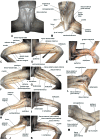



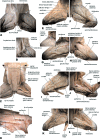




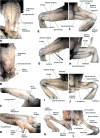

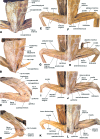

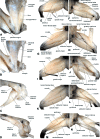






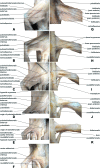
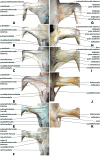

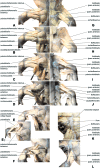

Similar articles
-
Comparative muscle anatomy of the anuran pelvis and hindlimb in relation to locomotor mode.J Anat. 2024 Nov;245(5):751-774. doi: 10.1111/joa.14122. Epub 2024 Aug 9. J Anat. 2024. PMID: 39119773 Free PMC article.
-
The evolution of jumping in frogs: morphological evidence for the basal anuran locomotor condition and the radiation of locomotor systems in crown group anurans.J Morphol. 2011 Feb;272(2):149-68. doi: 10.1002/jmor.10902. Epub 2010 Nov 8. J Morphol. 2011. PMID: 21210487
-
Phylogenetic patterns and correlation of key structures for jumping: bone crests and cross-sectional areas of muscles in Leptodactylus (Anura, Leptodactylidae).J Anat. 2018 May;232(5):870-885. doi: 10.1111/joa.12801. Epub 2018 Mar 8. J Anat. 2018. PMID: 29520773 Free PMC article.
-
The anuran Bauplan: a review of the adaptive, developmental, and genetic underpinnings of frog and tadpole morphology.Biol Rev Camb Philos Soc. 2007 Feb;82(1):1-25. doi: 10.1111/j.1469-185X.2006.00001.x. Biol Rev Camb Philos Soc. 2007. PMID: 17313522 Review.
-
Jumping ability of anuran amphibians.Adv Vet Sci Comp Med. 1994;38B:51-111. Adv Vet Sci Comp Med. 1994. PMID: 7810380 Review. No abstract available.
Cited by
-
Diversity and function of the fused anuran radioulna.J Anat. 2022 Oct;241(4):1026-1038. doi: 10.1111/joa.13737. Epub 2022 Aug 12. J Anat. 2022. PMID: 35962544 Free PMC article.
-
Cooperation behavior of fore- And hindlimbs during jumping in Rana dybowskii and Xenopus laevis.Ecol Evol. 2021 May 3;11(12):7569-7578. doi: 10.1002/ece3.7589. eCollection 2021 Jun. Ecol Evol. 2021. PMID: 34188835 Free PMC article.
-
Comparative muscle anatomy of the anuran pelvis and hindlimb in relation to locomotor mode.J Anat. 2024 Nov;245(5):751-774. doi: 10.1111/joa.14122. Epub 2024 Aug 9. J Anat. 2024. PMID: 39119773 Free PMC article.
-
Uncovering Sexual Differences in the External Morphology, Appendicular Muscles, and Internal Organs of a Fossorial Narrow-Mouth Frog (Kaloula borealis).Animals (Basel). 2025 Jul 17;15(14):2118. doi: 10.3390/ani15142118. Animals (Basel). 2025. PMID: 40723583 Free PMC article.
-
Digital dissection of the pelvis and hindlimb of the red-legged running frog, Phlyctimantis maculatus, using Diffusible Iodine Contrast Enhanced computed microtomography (DICE μCT).PeerJ. 2019 Jun 7;7:e7003. doi: 10.7717/peerj.7003. eCollection 2019. PeerJ. 2019. PMID: 31211012 Free PMC article.
References
-
- Anderson JS, Reisz RR, Scott D, Fröbisch NB, Sumida SS. A stem batrachian from the early Permian of Texas and the origin of frogs and salamanders. Nature. 2008;453:515–518. - PubMed
-
- Blanco MJ, Sanchiz B. Evolutionary mechanisms of rib loss in anurans: a comparative developmental approach. J Morphol. 2000;244:57–67. - PubMed
-
- Böker H. Einführung in Die Vergleichende Biologische Anatomie der Wirbeltiere. Vol. 1. Jena: Gustav Fischer; 1935.
-
- Boy JA. Die Larven der rhachitomen Amphibien (Amphibia: temnospondyli; Karbon-Trias) Paläont Z. 1974;48:236–268.
-
- Boy JA, Sues H-D. Branchiosaurs: larvae, metamorphosis and heterochrony in temnospondyls and seymouriamorphs. In: Heatwole H, Carroll R, editors. Amphibian Biology – Paleontology. Chipping Norton: Surrey Beatty & Sons; 2000. pp. 1150–1197.
Publication types
MeSH terms
LinkOut - more resources
Full Text Sources
Research Materials

